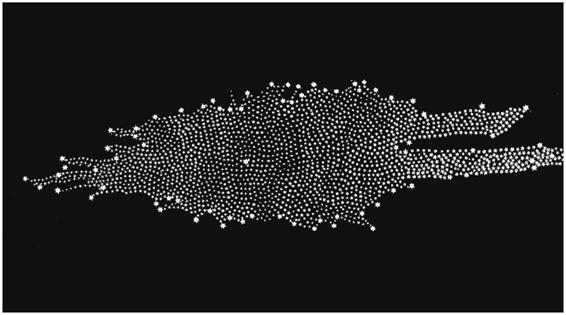JF Ptak Science Books Post 1054 The History of Dots series
[Thanks to Randall Rosenfeld of the University of Toronto for sparking this post!]
It seems that few people now remember Frederick William Herschel as a great discoverer of alternative existences, but, well, that's pretty much what he did--and he did it during a time that must've made his astronomical discoveries seem like science fiction .For example, in 1785 Herschel published a revolutionary image of the “Stellar System” (the Milky Way), showing its irregular pattern and the off-center placement of our sun amidst a panoply of other stars.
(His image was remarkably and substantially correct, with the most grievous error being the placement of the sun too close to the center of the galaxy.) It was an image which bought the concept of a not so humano-centric idea into popular philosophy, and that our sun was a star among stars in a sea of stars1.
Not only that, but Herschel also made observations on double stars that showed that Newton's laws of gravitation extended throughout the universe, and that it was possible for the stars themselves to submit to these laws and react to each other. After constructing his mammoth four-foot telescope, Herschel expanded the observable sky multifold, showing that there was a possible 75 million stars now available for study. And if the stars were behaving like planets then the actions of our own solar system seem perhaps to be not so unique; and with all of these new stars the possibilities for new planets and new solar system (and with that the possibilities for other life forms) seems a greater possibility.
And on these new worlds in these new solar systems there was therefore the possibility of two or more suns, meaning that there could be sets of shadows cast by anyone/thing on the surfaces of any of these new worlds.
In fact Herschel was able to show that our own Sun was following a prescribed path through the Milky Way, making Sol much less of spectacular enigma of mythical importance and more of just another starry dot in a sea of dots. And while he was making the Sun into a starry dot he was also resolving those other starry dots into something of greater understanding and significance, bringing them into a systemic mechanism of the universe.
Herschel also made an alpha/omega kind of discovery, as well--he marveled at nebulous "holes"2 that he was finding in the Milky Way, thinking that, perhaps, he was looking into the very soul of the universe, at the place where stars were born.
This is extraordinary stuff coming to use from 200 years ago. Few people have made such enormous and concrete contributions with such far reaching intellectual and philosophical implications. So hats-off tonight to Frederick William Herschel, a man with big eyes.
Notes:
1. This galacto-centric view remained until the work of Harlow Shapley's globular clusters in 1918.
2. Specifically his famous and luscious "Coalsack" nebula.




Comments